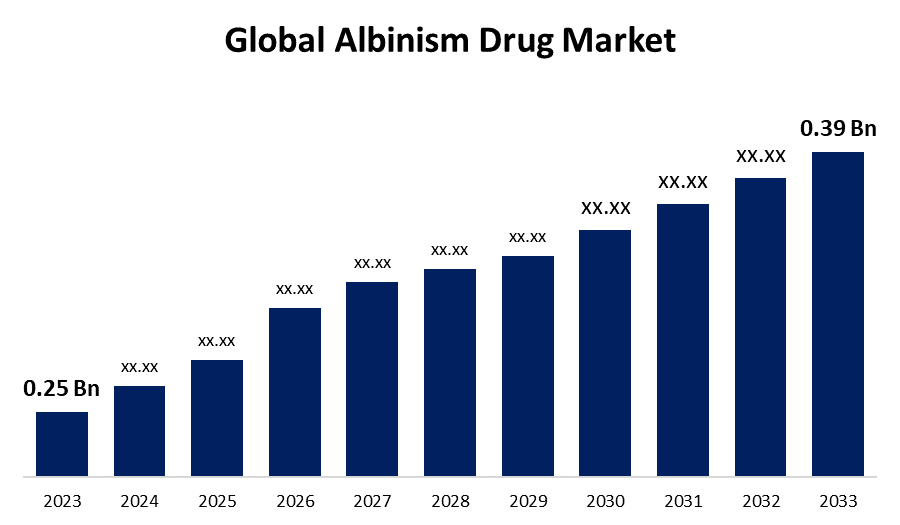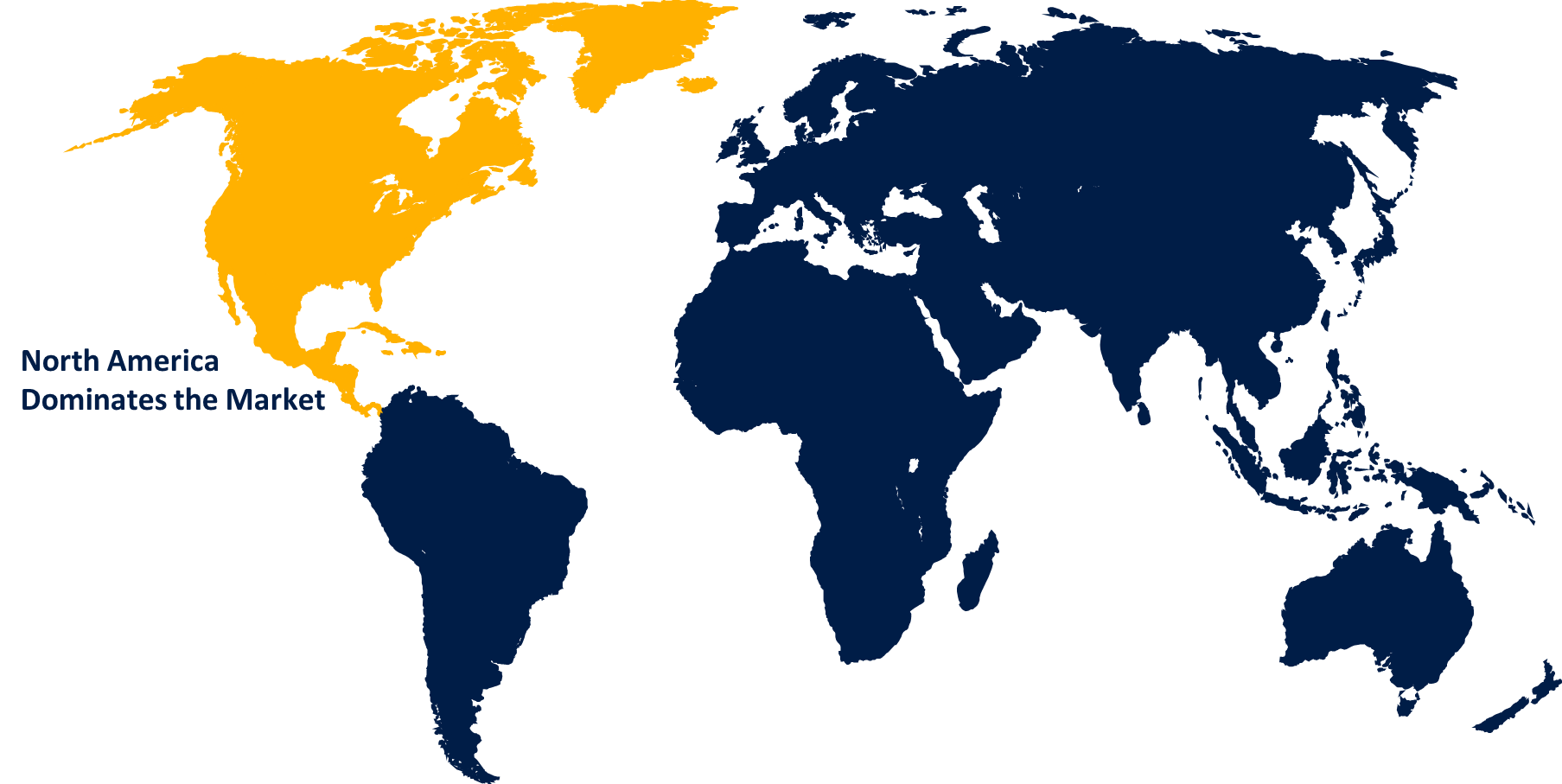Global Albinism Drug Market Size, Share, and COVID-19 Impact Analysis, By Type (Ocular Albinism, Oculocutaneous Albinism, and Others), By Route of Administration (Oral, Topical, and Injectable), By End-User (Hospitals, Specialty Clinics, and Research Institutions), and By Region (North America, Europe, Asia-Pacific, Latin America, Middle East, and Africa), Analysis and Forecast 2023 - 2033.
Industry: HealthcareGlobal Albinism Drug Market Insights Forecasts to 2033
- The Global Albinism Drug Market Size was Valued at USD 0.25 Billion in 2023
- The Market Size is Growing at a CAGR of 4.55% from 2023 to 2033
- The Worldwide Albinism Drug Market Size is Expected to Reach USD 0.39 Billion by 2033
- Asia Pacific is Expected to Grow the fastest during the forecast period.

Get more details on this report -
The Global Albinism Drug Market Size is Anticipated to Exceed USD 0.39 Billion by 2033, Growing at a CAGR of 4.55% from 2023 to 2033.
Market Overview
Albinism is a genetic condition that reduces the production of melanin, causing a fair skin tone, light eyes, and increased susceptibility to skin and eye conditions. Melanin, the pigment that gives skin and hair color, is found in the epidermis, hair, and eyes. It helps protect the body against UV radiation, preventing skin damage and cancers. There are two main forms of melanin: eumelanin and pheomelanin, with their relative amounts influenced by a person's genetic makeup. Eumelanin is the most common type, responsible for brown to black pigmentation, while pheomelanin is responsible for yellow to red hues in hair, skin, and lips. Albinism can be categorized into two major types: oculo-cutaneous albinism (OCA) which affects the eyes, hair, and skin, and ocular albinism (OA), which is less common and affects only the eyes. Albinism is diagnosed based on the observed decreased or absent pigmentation compared to the same family or ethnic group.
Report Coverage
This research report categorizes the market for the global albinism drug based on various segments and regions forecasts revenue growth and analyzes trends in each submarket. The report analyses the key growth drivers, opportunities, and challenges influencing the global albinism drug market. Recent market developments and competitive strategies such as expansion, product launch, and development, partnership, merger, and acquisition have been included to draw the competitive landscape in the market. The report strategically identifies and profiles the key market players and analyses their core competencies in each sub-segment of the global albinism drug market.
Global Albinism Drug Market Report Coverage
| Report Coverage | Details |
|---|---|
| Base Year: | 2023 |
| Market Size in 2023: | USD 0.25 Billion |
| Forecast Period: | 2023 - 2033 |
| Forecast Period CAGR 2023 - 2033 : | 4.55% |
| 2033 Value Projection: | USD 0.39 Billion |
| Historical Data for: | 2019-2022 |
| No. of Pages: | 231 |
| Tables, Charts & Figures: | 110 |
| Segments covered: | By Type, By Route of Administration, By End-User, By Region |
| Companies covered:: | Alnylam Pharmaceuticals, Inc., Amgen Inc., Genentech, Inc., Novartis AG, Regeneron Pharmaceuticals, Inc., Pfizer Inc., AbbVie Inc., Takeda Pharmaceutical Company, Roche Holding AG, Sanofi S.A., Merck & Co., Inc., Bristol-Myers Squibb Company, Vertex Pharmaceuticals Incorporated, BioMarin Pharmaceutical Inc., Celgene Corporation, and Others |
| Pitfalls & Challenges: | Covid 19 Impact Challanges, Future, Growth and Analysis |
Get more details on this report -
Driving Factors
The albinism drug market is driven by increasing awareness and diagnosis of the condition, research into gene therapies, personalized medicine for tailored therapy, and the prevalence of albinism in various populations. The rising incidences of vision problems and skin disorders further fuel the demand for therapeutic interventions. Collaborations between pharmaceutical companies and research institutions accelerate the development of innovative treatments, while increased funding for rare disease research and advocacy efforts contribute to a supportive environment for drug development in this niche market.
Restraining Factors
The albinism drug market faces challenges such as limited awareness, a small patient population, regulatory hurdles, and complex genetic disorders. This leads to underdiagnosis and insufficient demand for treatments. Pharmaceutical companies may be hesitant to invest in research due to perceived low profitability. Regulatory hurdles and lengthy approval processes further delay the introduction of innovative treatments. Limited funding and resources for rare disease research may also hinder advancements in the albinism drug market.
Market Segmentation
The global albinism drug market share is classified into type, route of administration, and end-user.
- The oculocutaneous albinism segment is expected to hold the largest share of the global albinism drug market during the forecast period.
Based on the type, the global albinism drug market is divided into ocular albinism, oculocutaneous albinism, and others. Among these, the oculocutaneous albinism, segment is expected to hold the largest share of the global albinism drug market during the forecast period. The oculocutaneous albinism segment is expected to grow significantly due to its impact on both the skin and eyes, causing vision problems and increased sensitivity to sunlight. As awareness of the condition increases, there is a growing demand for targeted treatments, including specialized lenses and surgical interventions. Advancements in therapies and research on genetic factors associated with this type of albinism are also expected to contribute to this growth.
- The topical segment is expected to grow at the fastest CAGR in the global albinism drug market during the forecast period.
Based on the route of administration, the global albinism drug market is divided into oral, topical, and injectable. Among these, the topical segment is expected to grow at the fastest CAGR in the global albinism drug market during the forecast period. Topical treatments are crucial for individuals with albinism due to their skin's sensitivity and increased sun damage susceptibility. Products like sunscreens, moisturizers, and specialized skin care formulations protect the skin from harmful UV rays and manage dryness and irritation. Research into topical therapies promoting melanin production or enhancing skin pigmentation could expand the range of treatments. The convenience and ease of use make topical products appealing for ongoing skin care and protection.
- The specialty clinics segment is expected to grow at the fastest CAGR in the global albinism drug market during the forecast period.
Based on the end-user, the global albinism drug market is divided into hospitals, specialty clinics, and research institutions. Among these, the public charging segment is expected to grow at the fastest CAGR in the global albinism drug market during the forecast period. Specialty clinics are expected to experience significant growth in the albinism drug market, offering specialized care like eye examinations and targeted therapies. As healthcare professionals become more aware of albinism, more patients are seeking treatment from these facilities. The emphasis on personalized medicine and patient-centered care makes them a preferred choice for albinism management. Collaborations between specialty clinics and pharmaceutical companies can facilitate access to innovative therapies and clinical trials.
Regional Segment Analysis of the Global Albinism Drug Market
- North America (U.S., Canada, Mexico)
- Europe (Germany, France, U.K., Italy, Spain, Rest of Europe)
- Asia-Pacific (China, Japan, India, Rest of APAC)
- South America (Brazil and the Rest of South America)
- The Middle East and Africa (UAE, South Africa, Rest of MEA)
North America is anticipated to hold the largest share of the global albinism drug market over the predicted timeframe.

Get more details on this report -
North America is anticipated to hold the largest share of the global albinism drug market over the predicted timeframe. North America is expected to dominate the global albinism drug market due to advanced healthcare infrastructure, high genetic awareness, and significant research investments. Leading pharmaceutical companies and biotech firms in the US are driving the development of innovative therapies, including gene therapies and targeted treatments. The region's emphasis on personalized medicine and increased patient advocacy further boosts awareness and promotes research initiatives.
Asia Pacific is expected to grow at the fastest pace in the global albinism drug market during the forecast period. The region is expected to experience the fastest growth in the global albinism drug market due to increased awareness and diagnosis, particularly in countries like China and India. The growing prevalence of genetic disorders in these populations has led to a focus on developing targeted therapies. The region's growing pharmaceutical industry and investments in research drive innovations in drug formulations and delivery methods.
Competitive Analysis:
The report offers the appropriate analysis of the key organizations/companies involved within the global albinism drug market along with a comparative evaluation primarily based on their product offering, business overviews, geographic presence, enterprise strategies, segment market share, and SWOT analysis. The report also provides an elaborative analysis focusing on the current news and developments of the companies, which includes product development, innovations, joint ventures, partnerships, mergers & acquisitions, strategic alliances, and others. This allows for the evaluation of the overall competition within the market.
List of Key Companies
- Alnylam Pharmaceuticals, Inc.
- Amgen Inc.
- Genentech, Inc.
- Novartis AG
- Regeneron Pharmaceuticals, Inc.
- Pfizer Inc.
- AbbVie Inc.
- Takeda Pharmaceutical Company
- Roche Holding AG
- Sanofi S.A.
- Merck & Co., Inc.
- Bristol-Myers Squibb Company
- Vertex Pharmaceuticals Incorporated
- BioMarin Pharmaceutical Inc.
- Celgene Corporation
- Others
Key Target Audience
- Market Players
- Investors
- End-users
- Government Authorities
- Consulting And Research Firm
- Venture capitalists
- Value-Added Resellers (VARs)
Recent Developments
- In January 2022, The National Eye Institute (NEI) created the first patient-derived stem cell model for studying eye conditions related to oculocutaneous albinism (OCA).
Market Segment
This study forecasts revenue at global, regional, and country levels from 2020 to 2033. Spherical Insights has segmented the global albinism drug market based on the below-mentioned segments:
Global Albinism Drug Market, By Type
- Ocular Albinism
- Oculocutaneous Albinism
- Others
Global Albinism Drug Market, By Route of Administration
- Oral
- Topical
- Injectable
Global Albinism Drug Market, By End-User
- Hospitals
- Specialty Clinics
- Research Institutions
Global Albinism Drug Market, Regional
- North America
- US
- Canada
- Mexico
- Europe
- Germany
- UK
- France
- Italy
- Spain
- Russia
- Rest of Europe
- Asia Pacific
- China
- Japan
- India
- South Korea
- Australia
- Rest of Asia Pacific
- South America
- Brazil
- Argentina
- Rest of South America
- Middle East & Africa
- UAE
- Saudi Arabia
- Qatar
- South Africa
- Rest of the Middle East & Africa
Frequently Asked Questions (FAQ)
-
1. Which are the key companies that are currently operating within the market?Alnylam Pharmaceuticals, Inc., Amgen Inc., Genentech, Inc., Novartis AG, Regeneron Pharmaceuticals, Inc., Pfizer Inc., AbbVie Inc., Takeda Pharmaceutical Company, Roche Holding AG, Sanofi S.A., Merck & Co., Inc., Bristol-Myers Squibb Company, Vertex Pharmaceuticals Incorporated, BioMarin Pharmaceutical Inc., Celgene Corporation, and Others.
-
2. What is the size of the global albinism drug market?The Global Albinism Drug Market Is Expected To Grow From USD 0.25 Billion In 2023 To USD 0.39 Billion By 2033, At A CAGR Of 4.55% During the forecast period 2023-2033.
-
3. Which region is holding the largest share of the market?North America is anticipated to hold the largest share of the global albinism drug market over the predicted timeframe.
Need help to buy this report?